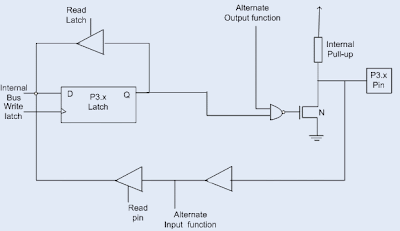8051 micro-controller have four I/O port to perform input and output operation.this port also perform alternative function except port1.each port contain 8 pins in it.there are 32 pin for this functions.
PORT-0
It has 8 pins (P0.0-P0.7).
The structure of a Port-0 pin is shown in below fig.
Port-0 can be configured as a normal bidirectional I/O port or it can be used for address/data interfacing for accessing external memory.When control is '1', the port is used for address/data interfacing. When the control is '0', the port can be used as a normal bidirectional I/O port.
Port-3 pins have alternate functions.
The structure of a port-3 pin is shown in fig.
Each pin of Port-3 can be individually programmed for I/O operation or for alternate function. The alternate function can be activated only if the corresponding latch has been written to '1'. To use the port as input port, '1' should be written to the latch. This port also has internal pull-up and limited current driving capability.
PORT-0
It has 8 pins (P0.0-P0.7).
The structure of a Port-0 pin is shown in below fig.
Port-0 can be configured as a normal bidirectional I/O port or it can be used for address/data interfacing for accessing external memory.When control is '1', the port is used for address/data interfacing. When the control is '0', the port can be used as a normal bidirectional I/O port.
Let us assume that control is '0'. When the port is used as an input
port, '1' is written to the latch. In this situation both the output
MOSFETs are 'off'. Hence the output pin floats. This high impedance pin
can be pulled up or low by an external source. When the port is used as
an output port, a '1' written to the latch again turns 'off' both the
output MOSFETs and causes the output pin to float. An external pull-up
is required to output a '1'. But when '0' is written to the latch, the
pin is pulled down by the lower MOSFET. Hence the output becomes zero.
When the control is '1', address/data bus controls the output driver
MOSFETs. If the address/data bus (internal) is '0', the upper MOSFET is
'off' and the lower MOSFET is 'on'. The output becomes '0'. If the
address/data bus is '1', the upper transistor is 'on' and the lower
transistor is 'off'. Hence the output is '1'. Hence for normal
address/data interfacing (for external memory access) no pull-up
resistors are required.
Port-1
Port-1 has 8 pins (P1.1-P1.7) .
The structure of a port-1 figure shown below.
Port-1 does not have any alternate function i.e. it is dedicated solely
for I/O interfacing.When used as output port, the pin is pulled up or
down through internal pull-up. To use port-1 as input port, '1' has to
be written to the latch. In this input mode when '1' is written to the
pin by the external device then it read fine. But when '0' is written to
the pin by the external device then the external source must sink
current due to internal pull-up. If the external device is not able to
sink the current the pin voltage may rise, leading to a possible wrong
reading.
PORT-2
Port-2 has 8-pins (P2.0-P2.7) .
The structure of a port-2 pin is shown in fig.
Port-2 is used for higher external address byte or a normal input/output
port. The I/O operation is similar to Port-1. Port-2 latch remains
stable when Port-2 pin are used for external memory access. Here again
due to internal pull-up there is limited current driving capability.
PORT 3
Port-3 has 8 pin (P3.0-P3.7) .Port-3 pins have alternate functions.
The structure of a port-3 pin is shown in fig.
Each pin of Port-3 can be individually programmed for I/O operation or for alternate function. The alternate function can be activated only if the corresponding latch has been written to '1'. To use the port as input port, '1' should be written to the latch. This port also has internal pull-up and limited current driving capability.
Alternative function of port3











0 comments:
Post a Comment